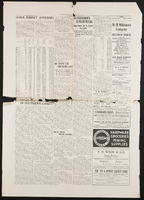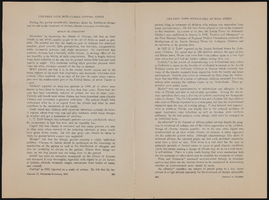Search the Special Collections and Archives Portal
Search Results

Transcript of interview with Jack Bullock by Julie Domonkos, March 15, 1981
Date
Archival Collection
Description
Text

Las Vegas Sentinel Voice, October 20, 1983
Date
Description
Full edition of the October 20, 1983 issue of the Las Vegas Sentinel-Voice.
Text
Six Companies, Inc. Hoover Dam Photograph Collection
Identifier
Abstract
The Six Companies, Inc. Hoover Dam Photograph Collection (1931-1935), consists of approximately 400 black-and-white photographic prints contained in two photograph albums and an additional twenty-one loose black-and-white photographic prints with ten corresponding photographic negatives.
Archival Collection
Richard Ronzone Photographs
Identifier
Abstract
The Richard Ronzone Photographs depict Las Vegas, Nevada storeowner and politician Richard “Dick” Ronzone and his family from 1920 to 1989 and 2001. The photographs primarily depict Ronzone at Ronzone’s Store in Las Vegas, at events with politicians such as Nevada Governor Paul Laxalt, or at the Las Vegas Valley Water District. The photographs also depict Ronzone during his service with the Nevada National Guard; portraits of Ronzone, his wife Ann Roeth Ronzone, and his mother Bertha Ronzone; and events during Ronzone’s tenure as a Clark County Commissioner from 1972 to 1980.
Archival Collection
Bob Coffin Political Papers
Identifier
Abstract
The Bob Coffin Political Papers (approximately 1861-2021) document the political career of independent Democrat Bob Coffin who served in the Nevada Assembly, State Senate, and Las Vegas City Council from 1983 to 2019. Collection materials primarily consist of legislative research files associated with Coffin's committee assignments. City Council records in this collection include budget files, constituent concerns, and city project files. The collection also includes election materials used for Coffin's political campaigns and include posters, mailers, as well as newspaper clippings and information on Coffin's opponents.
Archival Collection
Maria Pogee Papers
Identifier
Abstract
The Maria Pogee Papers (1942-2019) document the life and career of Argentinian born dancer, choreographer, and actress, Maria Pogee. Pogee worked extensively in Argentina, Chile, Lebanon, around the United States and in Las Vegas, Nevada. Materials include press clippings, show programs, correspondence, and photographs representing Pogee's entertainment career such as her work in the stage production of
Archival Collection
Amy Ayoub Papers
Identifier
Abstract
The Amy Ayoub Papers (1906-2022) document the life and career of Amy Ayoub, a long-time resident of Las Vegas, Nevada. The collection consists of correspondence, photographs, newspaper clippings, research, and other material that document the numerous facets of Ayoub's life. The collection covers many areas: Ayoub's early childhood; her family, including father Bobby Ayoub and stepfather Raymond Sutton; her financial consulting career and political work; her experience working as a prostitute in Nevada and subsequent documentary about being sex trafficked and working in brothels; time spent as the first female Nevada Athletic Commissioner; and more. Digital files include audio and video files of Mike Tyson's 2002 licensure hearing, and video of Ayoub's testimony before the Nevada State Assembly Judiciary Committee for Assembly Bill 67 in 2013. There are also digitized photographs that Ayoub used for the documentary The Zen Speaker: Breaking the Silence.
Archival Collection


